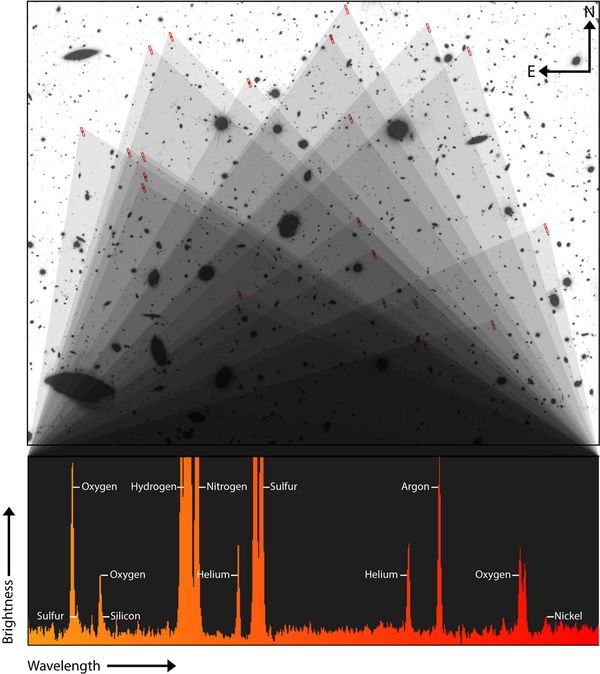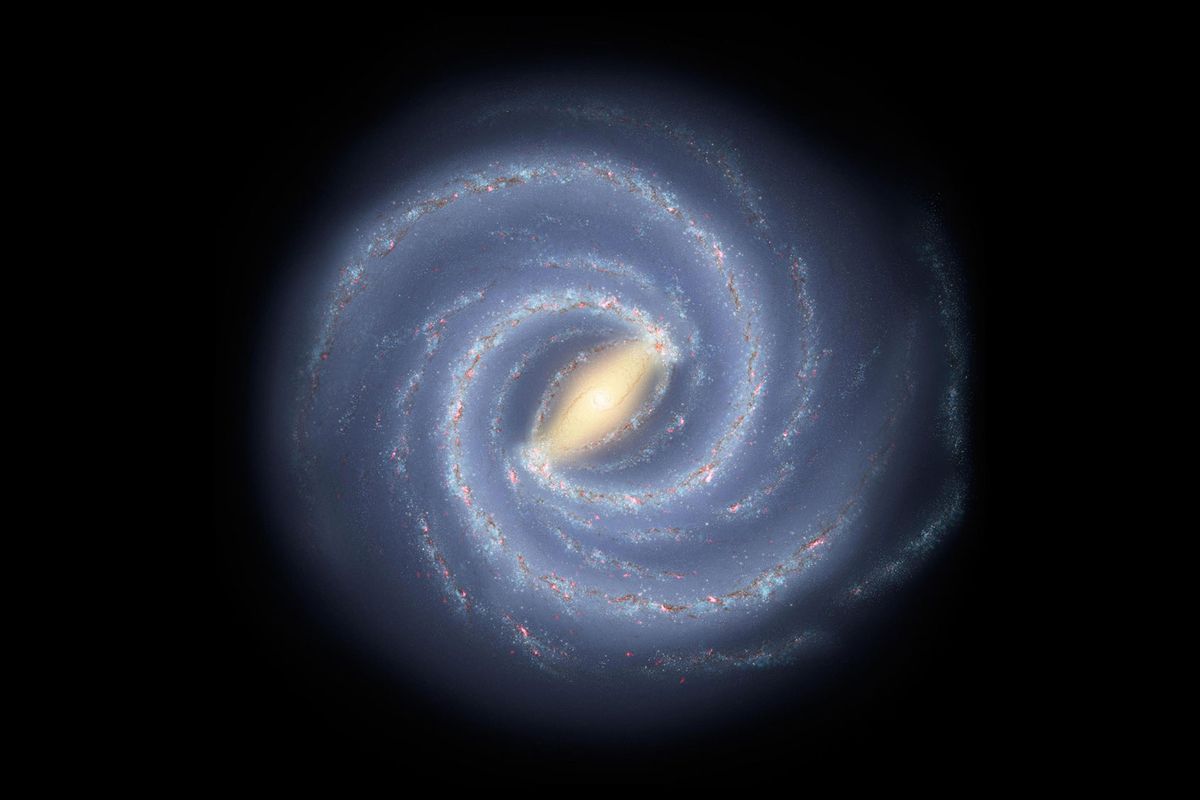Our home galaxy, the Milky Way, is known for its famous, sparkly, spiral.
But we aren’t the only ones with a glittery arm. Known as spiral galaxies, this class of galaxy is known to make up an estimated 60 percent of all galaxies in the universe. Found in low-density regions of the universe, spiral galaxies aren't common in every corner of the universe. In fact, they are rare in the middle of galaxy clusters.
And it turns out there is a part of the universe called a Supergalactic Plane, which is an enormous flattened structure that extends nearly a billion light years across, that’s teeming with bright elliptical and bright disk galaxies —but curiously, no spiral galaxies. An international team of researchers wanted to know: why are spiral galaxies like our very own Milky Way missing from the Supergalactic Plane? And what can that tell us about the evolution of our galaxy?
They might have found an answer. New research in the journal Nature Astronomy reports spiral galaxies are scarce in the Supergalactic Plane because in this region, galaxies are frequently merging with other galaxies.
Think of it like a very populated city, or a very busy highway. Through these mergers, spiral galaxies turn into elliptical galaxies, egg-shaped galaxies without the spiral arms, which leads to the growth of supermassive black holes. (These black holes live up to their name, sometimes billions of times more massive than our sun.) In contrast, spiral galaxies that don’t populate the Supergalactic Plane evolve in isolation, allowing them to keep their picture-perfect spiral.
"Our simulation reveals the intimate details of the formation of galaxies such as the transformation of spirals into ellipticals through galaxy mergers."
The team of researchers landed on their conclusion using the SIBELIUS (Simulations Beyond the Local Universe) supercomputer simulation. Through this simulation they tracked the evolution of the universe over 13.8 billion years, from the early universe to today. The researchers said the final simulation was consistent with observations of our universe through telescopes.
“It is rare but not a complete anomaly: our simulation reveals the intimate details of the formation of galaxies such as the transformation of spirals into ellipticals through galaxy mergers,” co-author Professor Carlos Frenk said in a media statement. “Further, the simulation shows that our standard model of the Universe, based on the idea that most of its mass is cold dark matter, can reproduce the most remarkable structures in the Universe, including the spectacular structure of which the Milky Way is part.”
 Distribution of the brightest galaxies in the Local Universe, observed in the 2MASS survey (left panel) and reproduced in the SIBELIUS simulation (right panel). (Dr Till Sawala)Astronomers believe the Milky Way is an estimated 13.51 billion years old. However, what happened during each stage of its evolution, and how long those phases lasted to get to its current form today, remains unclear. A leading theory is that the Milky Way's collision with a dwarf galaxy nearly 10 billion years ago was a turning point, setting in motion the changes that amounted to our modern galaxy. Others believe that our galaxy might have matured earlier than previously thought. Either way, just like humans, galaxies go through different stages of maturation.
Distribution of the brightest galaxies in the Local Universe, observed in the 2MASS survey (left panel) and reproduced in the SIBELIUS simulation (right panel). (Dr Till Sawala)Astronomers believe the Milky Way is an estimated 13.51 billion years old. However, what happened during each stage of its evolution, and how long those phases lasted to get to its current form today, remains unclear. A leading theory is that the Milky Way's collision with a dwarf galaxy nearly 10 billion years ago was a turning point, setting in motion the changes that amounted to our modern galaxy. Others believe that our galaxy might have matured earlier than previously thought. Either way, just like humans, galaxies go through different stages of maturation.
A separate study published in The Astrophysical Journal Letters highlights unexpected observations in “teenage galaxies,” meaning galaxies that formed two-to-three billion years after the Big Bang.
Want more health and science stories in your inbox? Subscribe to Salon's weekly newsletter Lab Notes.
In the study, a group of scientists at Northwestern University analyzed the results from the CECILIA (Chemical Evolution Constrained using Ionized Lines in Interstellar Aurorae) Survey, which used NASA’s James Webb Space Telescope (JWST) to study the chemistry of faraway galaxies. The results showed that these so-called teenage galaxies go through an uncomfortable growth spurt during their teenage years, similar to humans.
“Using the JWST, our program targets teenage galaxies when they were going through a messy time of growth spurts and change,” Northwestern’s Allison Strom, who led the study, said in a media statement. “Teenagers often have experiences that determine their trajectories into adulthood. For galaxies, it’s the same.”
In order to make these discoveries, Strom and her collaborators used the JWST to observe 33 distant teenaged galaxies for 30 straight hours. Then, they combined spectra from 23 of those galaxies. Strom emphasized that the biggest surprises were the observations of nickel and finding that the teenage galaxies were extremely hot.
“This is just additional evidence of how different galaxies likely were when they were younger,” Strom said. “Never in my wildest dreams did I imagine we would see nickel.”
 Light from 23 distant galaxies, identified with red rectangles in the Hubble Space Telescope image at the top, were combined to capture incredibly faint emission from eight different elements, which are labelled in the JWST spectrum at the bottom. (Aaron M. Geller, Northwestern, CIERA + IT-RCDS)
Light from 23 distant galaxies, identified with red rectangles in the Hubble Space Telescope image at the top, were combined to capture incredibly faint emission from eight different elements, which are labelled in the JWST spectrum at the bottom. (Aaron M. Geller, Northwestern, CIERA + IT-RCDS)
Dr. Gwen Rudie, a staff astronomer at Carnegie Observatories, clarified to Salon via email that the elements existing in these galaxies is not a surprise, but the ability measure their light is "unprecedented" and underscores the power of JWST.
"The pattern we see in the light from these different elements (how brightly the signatures of each element glow) is very different from what we see in local galaxies - and our own galaxy," Rudie said. "So explaining why the pattern in their spectra is different and what it means for these early galaxies is the next big puzzle."
We need your help to stay independent
Rudie added that astronomers have a pretty good idea of how galaxies like the Milky Way formed, but there are "very important clues missing." The most important one, she said, is the chemistry makeup of the galaxy.
Strom further elaborated that the most growth for a galaxy occurs during this period, making the case for why it’s an important timespan to study. It also could hold clues to why the Milky Way has its spiral arm.
“By studying this, we can begin exploring the physics that caused the Milky Way to look like the Milky Way,” she said. “And why it might look different from its neighboring galaxies.”



Shares